Welcome to the latest installment in our annotations of the collected edition of The Trial of the Flash! A while back, we analyzed related stories leading up to the release of Showcase Presents: The Trial of the Flash. In addition, we interviewed author Cary Bates about the buildup and the Trial itself, plus showed you what wasn’t included in the collection (important to this post).
IN THESE ISSUES: “The Monitor Doesn’t Editorialize!”
Links to original artwork, scans and research are included throughout this post. For definitive legal analysis of the story by Bob Ingersoll, go here. Tom vs. Flash Podcast links here, including these issues. As always, huge thanks to the DC Indexes. See you after the jump!
We’ve arrived at the point in the Showcase Presents volume where the collection skips three issues, #s 337, 338 and 339. The Trial is already one of/the longest Showcase Presents editions at 592 pages, and 66 more pages would have put it at a whopping 658. These three issues introduce a couple major players and are marked by Bates’ intricate plotting and rich dialog.
ISSUE #337
COVER by Carmine Infantino and Klaus Janson. The Sound of Music reference here joins a more contemporary one from the Pied Piper’s last Flash encounter in issue #307, which features a line from Don McLean’s “American Pie” on the cover.
PG 1 & 2: Flash saved Mayor Pinchot from the Pied Piper last issue. Under Piper’s control, he had previously vetoed funds to restore The Flash Museum following vandalism orchestrated by the Piper. Pinchot first appeared in Flash #258, and even appeared with Flash in one issue of The Brave and The Bold (#194). The original artwork for these pages can be seen here and here, via Comic Art Fans.
PG 3: The reference to the “Mayor in New York” who said “How am I doin’?” refers to the late Ed Koch, who passed away just last year.
PG 5: Captain Frye’s comment in panel four are the first morsel readers are given as to Cecile Horton’s grudge against Flash.
PG 6: Hostage negotiator Lt. Mondale (no further appearances) appears to be a nod to former Vice President Walter Mondale and his role in the 1980-1 Iran Hostage Crisis.
PG 7: In one of my favorite speed-tricks, Flash catches a bullet in his teeth. Here is a list of six magicians who died performing “The Bullet Catch”.
PG 9: The Pied Piper’s alias here is Thomas Peterson. He is sometimes also referred to as Henry Rathaway along with the most familiar/current Hartley Rathaway. The multiple names is poked fun at a little in Flash #32 (1989) by William Messner-Loebs when Turtle-Man recites The Piper’s dossier.
PG 12: The Piper ignites the Flash dummy, but this article says sound waves can actually be used to fight fires.
The original artwork for page 16 can be seen here.
The major plot advancement here is the mystery of what happened between Flash and his lawyer’s father. One good side effect of DC leaving it to fans to buy these three issues is you get this letter from Flash himself at the end of this story:
ISSUE #338
COVER by Infantino and Janson. There have always been those who claim Infantino was “phoning it in” during this period in his career, but I disagree when we see a seasoned master experiment with cover designs like this one. His sense of design and the rhythm of his pages never faltered.
The original artwork for page one can be seen here.
PG 9: The power of the mind is frequently on display in Bates’ Flash. It is very real and used often as a plot device and even battlefield, from Melanie in the “Death of Iris Allen” arc, The Top’s possession of Henry Allen, Gorilla Grodd and his psychic war with William Dawson, among many other examples.
PG 10: Just last issue, Captain Boomerang referred to Piper as Thomas Peterson. Here, Mirror Master uses his “Rathaway” surname. On page 13 of this issue, Boomerang refers to him as “Henry”. Breedmore Mental Hospital’s only other appearances outside of the Trial appear to be in Pied Piper fanfic.
PG 11: At first, it seems possible that Dufus a.k.a Big Sir is one of the reasons these issues were not included. However, he was featured in a DC comic as recently as 2011.
PG 14 & 15: These are two of the most important pages omitted from the collection. We get the origin of Nathan Newbury, C.P.A., who plays a huge role down the stretch. Here’s page 14 and here’s page 15.
PG 17: The Rogues act as if they’re standing up for the Piper, but there is some fear at play as Flash has become unpredictable. The reader knows Flash didn’t rough up Piper as badly as the Rogues believe, but we also don’t know if he meant to kill Reverse-Flash, or if it was an accident. Flash says he doesn’t even know, back in issue #332. This is the first Rogues team-up of four or more (not including Flash #300’s visions or their “funeral” for Zoom in Flash #325) since Flash #256.
PG 18: Sid Dithers, P.I. was a sketch on SCTV in the late 1970s. He was portrayed by Eugene Levy.
PG 20: During the buildup to Crisis on Infinite Earths, The Monitor provided a number of Earth’s villains with weapons.
PG 21 & 22: Dufus/Big Sir is either mis-colored here, or they changed their minds and covered his arms and legs in blue on the cover. Big Sur is a region of the Central Coast of California.
There are a couple of major plot progressions here, plus the introduction of Nathan Newbury and Big Sir. Both will appear later in the volume, without explanation. The two-page Newbury sequence could have been included as-is, anywhere in middle of the collection.
ISSUE #339
PG 1: Big Sir is thankfully blue from here on out. The original artwork for this page can be viewed here.
PG 3: This is the second time the Rogues refer to Big Sir as “Baby Kong”. The first credited Baby Kong on film appeared in 1986’s King Kong Lives. The original artwork for this page is viewable here.
PG 4: “Warday” is also the title of a post-apocalyptic book written in 1984 (the same year as these issues) and published the following year. Original artwork can be seen here. Page five is here.
PG 7 & 8: I tend to view Big Sir as Bates’ commentary on the management of Crisis tie-ins/crossovers. The Rogues referring to him as “B.S.”, the name “Dufus”… The artwork for these pages can be seen here and here.
PG 12: Foreshadowing here with Horton’s comments about recognizing Barry. It is not just a “does she know?” moment.
PG 14: A parabolic mirror is a reflective surface that collects light/sound/radiation and concentrates it into a single point (focus). Here is a great video explaining parabolic and spherical mirrors.
PG 16: The Monitor/Lyla sequence is a more pointed meta-commentary on Big Sir and the Crisis-crossover. Lyla refers to the creation of Big Sir as “bizarre,” to which The Monitor states he has “no interest” in how his technology was being used, and that he does not “editorialize upon” the events unfolding. Bates intentionally created a strange character when DC gave him marching orders for a Crisis tie-in, and he had free rein as writer/editor.
PG 21: Cecile’s “The sooner this interminable case is over and done with…” reads similarly to the Monitor sequence.
The original artwork for page 22 is located here. While the introductions of Newbury and Big Sir are very important and Horton’s storyline progresses, the tone of these three issues is wild and there is some pretty clear commentary by Bates to that effect.
See you next weekend, when The Trial commences!

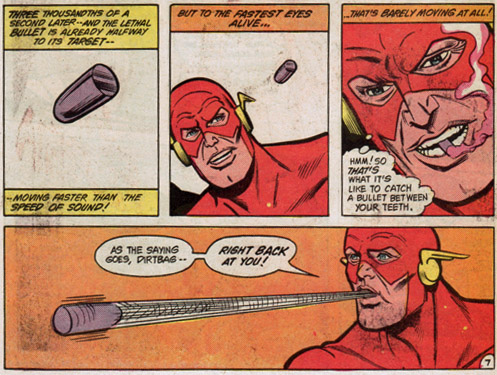
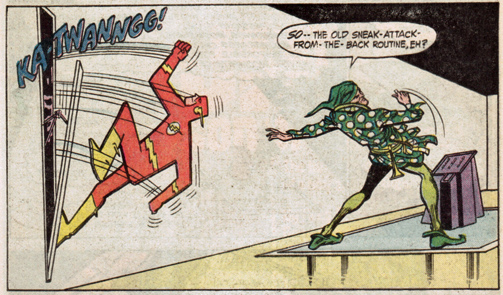
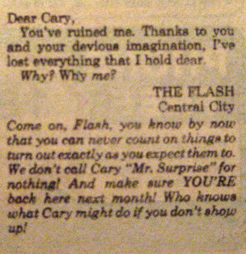
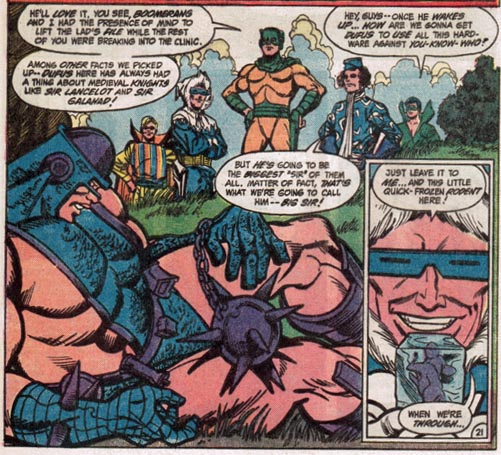
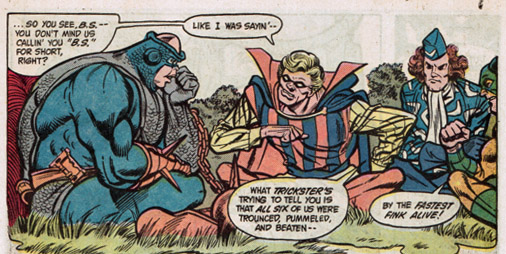
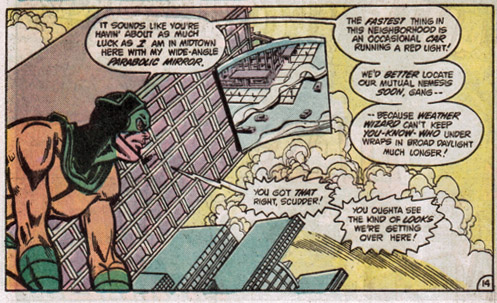
It’s been way too long since I’ve read these. I’d completely forgotten the Crisis foreshadowing, for instance. It *does* seem like Bates is commenting on that, doesn’t it?
That letter from the Flash is classic!